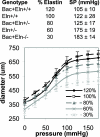Elastin in large artery stiffness and hypertension
- PMID: 22290157
- PMCID: PMC3383658
- DOI: 10.1007/s12265-012-9349-8
Elastin in large artery stiffness and hypertension
Abstract
Large artery stiffness, as measured by pulse wave velocity, is correlated with high blood pressure and may be a causative factor in essential hypertension. The extracellular matrix components, specifically the mix of elastin and collagen in the vessel wall, determine the passive mechanical properties of the large arteries. Elastin is organized into elastic fibers in the wall during arterial development in a complex process that requires spatial and temporal coordination of numerous proteins. The elastic fibers last the lifetime of the organism but are subject to proteolytic degradation and chemical alterations that change their mechanical properties. This review discusses how alterations in the amount, assembly, organization, or chemical properties of the elastic fibers affect arterial stiffness and blood pressure. Strategies for encouraging or reversing alterations to the elastic fibers are addressed. Methods for determining the efficacy of these strategies, by measuring elastin amounts and arterial stiffness, are summarized. Therapies that have a direct effect on arterial stiffness through alterations to the elastic fibers in the wall may be an effective treatment for essential hypertension.
Figures






References
-
- Mulvany MJ. Small artery remodelling in hypertension: causes, consequences and therapeutic implications. Med Biol Eng Comput. 2008;46(5):461–467. doi:10.1007/s11517-008-0305-3. - PubMed
-
- Kearney PM, Whelton M, Reynolds K, Muntner P, Whelton PK, He J. Global burden of hypertension: analysis of worldwide data. Lancet. 2005;365(9455):217–223. doi:10.1016/S0140-6736(05)17741-1. - PubMed
-
- Cecelja M, Chowienczyk P. Dissociation of aortic pulse wave velocity with risk factors for cardiovascular disease other than hypertension: a systematic review. Hypertension. 2009;54(6):1328–1336. doi:HYPERTENSIONAHA.109.137653 [pii] 10.1161/HYPERTENSIONAHA.109.137653. - PubMed
-
- Messerli FH, Frohlich ED, Ventura HO. Arterial compliance in essential hypertension. J Cardiovasc Pharmacol. 1985;7(Suppl 2):S33–35. - PubMed
-
- Faury G, Maher GM, Li DY, Keating MT, Mecham RP, Boyle WA. Relation between outer and luminal diameter in cannulated arteries. Am J Physiol. 1999;277(5 Pt 2):H1745–1753. - PubMed
Publication types
MeSH terms
Substances
Grants and funding
LinkOut - more resources
Full Text Sources
Other Literature Sources
Medical

